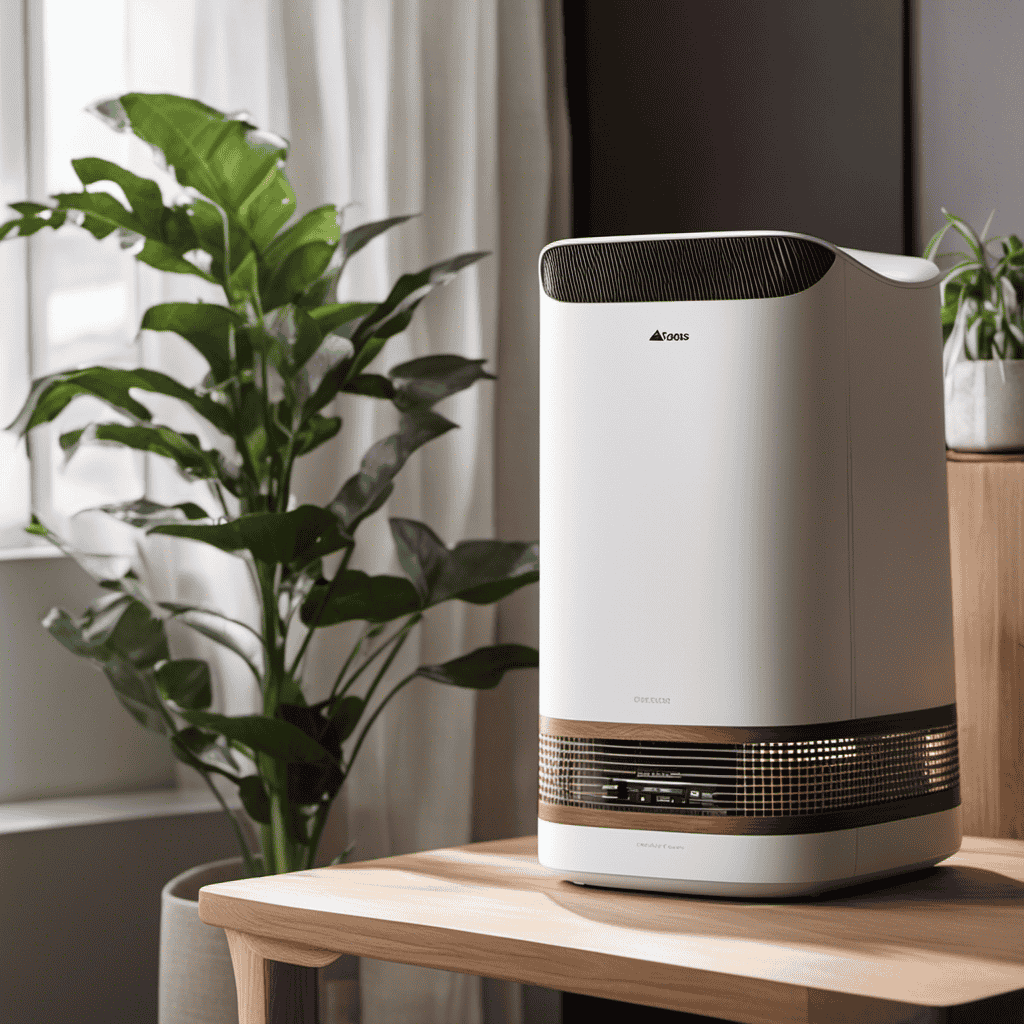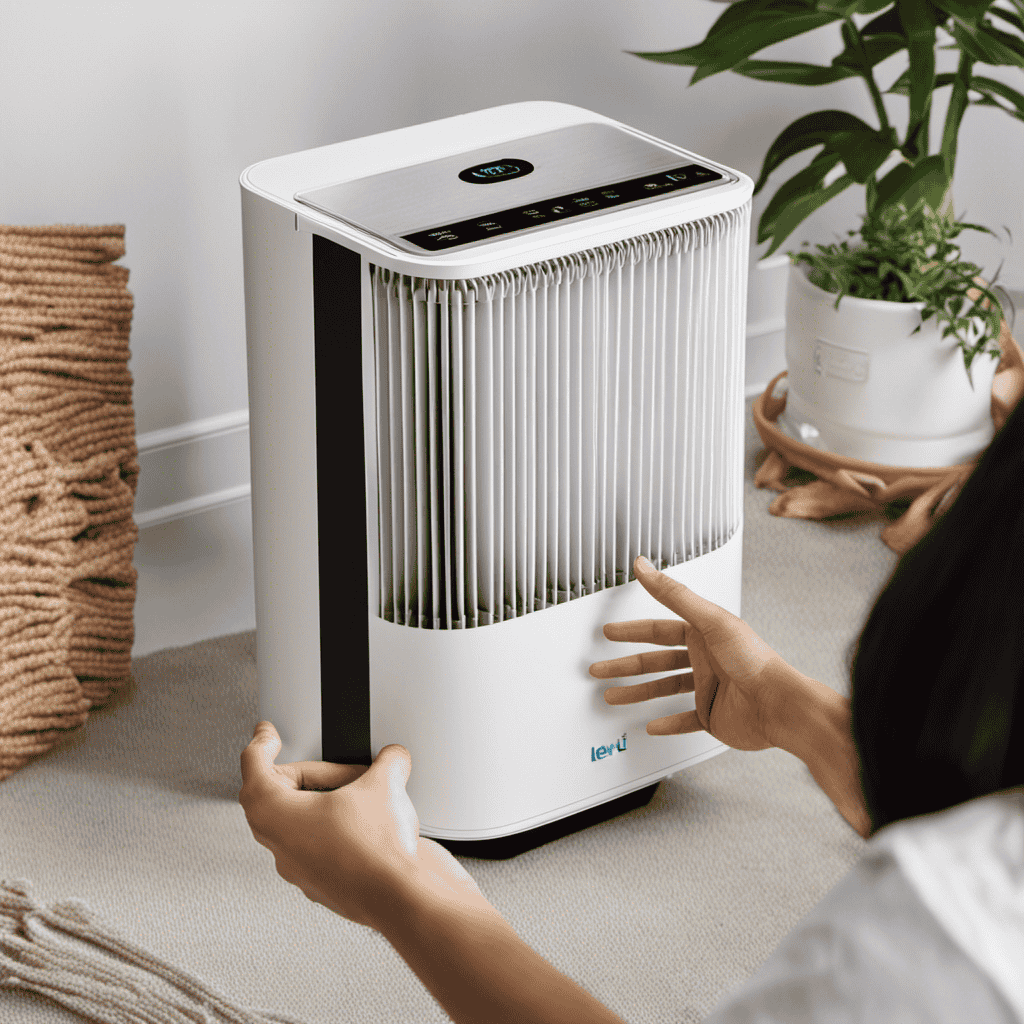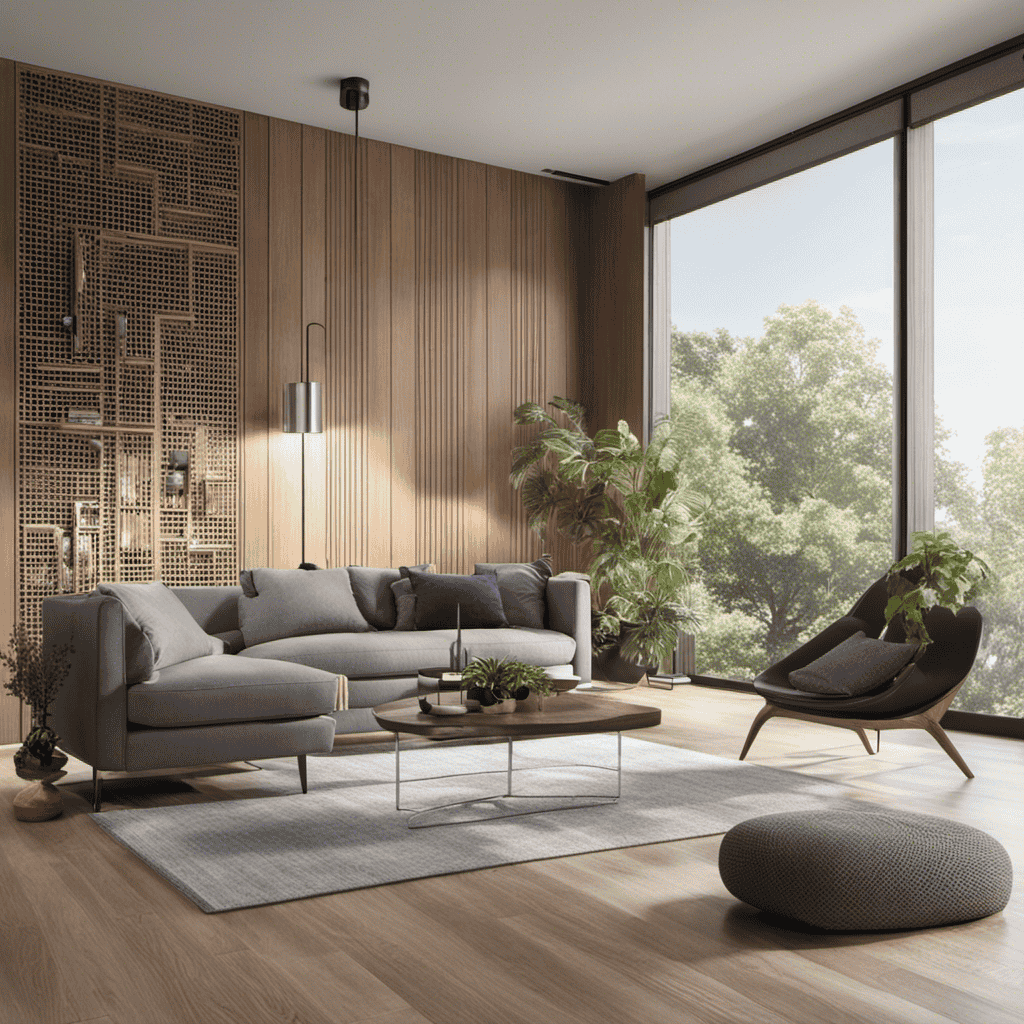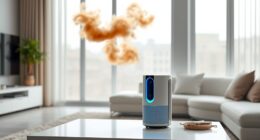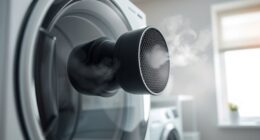Are you aware that using an air purifier can end up being more expensive than you realize? Recent studies have shown that the yearly operating expenses for an air purifier can go as high as $100.
In this article, I will delve into the factors that affect the running cost of air purifiers, such as energy efficiency and filter types. By understanding these factors, you’ll be able to make a more informed decision when it comes to choosing an air purifier that fits your needs and budget.
Key Takeaways
- Factors affecting the cost of running an air purifier include the size of the unit, type of filtration system used, and operating speed.
- Energy-saving features and certifications such as ENERGY STAR can help reduce the energy consumption and operating costs of air purifiers.
- Calculating the running cost involves determining the wattage of the purifier, multiplying it by the electricity rate, and estimating annual and lifetime operating expenses.
- Regular maintenance, filter replacement, and utilizing energy-saving features can help reduce energy consumption and analyze operating costs of air purifiers.
Understanding the Energy Consumption of Air Purifiers
Understanding the energy consumption of air purifiers can help you determine how much they’ll cost to run. When it comes to energy saving tips for air purifiers, it’s important to consider the impact of air quality on energy consumption.
Air purifiers are designed to remove pollutants and particles from the air, which means they require power to operate. The energy consumption of an air purifier depends on factors such as the size of the unit, the type of filtration system used, and the speed at which it operates.
Higher quality purifiers with advanced filtration systems may consume more energy, but they also tend to be more effective in improving air quality. By understanding the energy consumption of air purifiers, you can make informed decisions about which unit to choose based on your specific needs and budget.
Now let’s explore the factors affecting the operating cost of air purifiers.
Factors Affecting the Operating Cost of Air Purifiers
To determine the operating cost of your air purifier, you should consider factors such as electricity rates and usage time. Here are three key factors that can affect the operating cost of your air purifier:
-
Electricity rates: The cost of electricity can vary depending on your location and the rates charged by your utility provider. It’s important to research and compare the rates in your area to get an accurate estimate of the operating cost.
-
Usage time: The more you use your air purifier, the higher the operating cost will be. Consider how often and for how long you need to run the purifier to effectively clean your indoor air.
-
Energy-saving features: Some air purifiers come with energy-saving features, such as sleep mode or smart sensors that adjust the fan speed based on air quality. These features can help reduce energy consumption and lower operating costs.
When comparing the energy efficiency of different air purifiers, it’s essential to consider not only the initial cost but also their long-term operating costs. By taking into account factors like electricity rates, usage time, and energy-saving features, you can make an informed decision about which air purifier offers the best cost vs. performance ratio.
Comparing the Energy Efficiency of Different Air Purifiers
When comparing the energy efficiency of different air purifiers, it’s important to consider factors like electricity rates, usage time, and energy-saving features.
Energy-saving features can play a significant role in reducing the overall energy consumption of an air purifier. Look for features such as programmable timers, sleep mode, or auto-shutoff, which can help minimize unnecessary energy usage.
Additionally, consider the filter lifespan of the air purifier. A longer filter lifespan means less frequent filter replacements, which can contribute to energy savings in the long run.
It’s also worth noting that some air purifiers are ENERGY STAR certified, indicating that they meet strict energy efficiency guidelines set by the Environmental Protection Agency (EPA).
Taking these factors into account can help you choose an energy-efficient air purifier that meets your needs while minimizing energy consumption and operating costs.
How to Calculate the Running Cost of an Air Purifier
Calculating the running cost of an air purifier can be done by multiplying the wattage of the device by the average electricity rate. To estimate annual electricity expenses and calculate lifetime operating costs, follow these steps:
-
Determine the wattage of your air purifier. This information is usually available in the product specifications or user manual.
-
Find out the average electricity rate in your area. This can be obtained from your utility provider or by checking your electricity bill.
-
Multiply the wattage of the air purifier by the average electricity rate. This will give you the cost per hour of running the device.
To estimate annual electricity expenses, multiply the cost per hour by the number of hours you expect to run the air purifier each day, and then multiply that by 365 (the number of days in a year).
To calculate the lifetime operating costs, multiply the annual electricity expenses by the expected lifespan of the air purifier.
Average Daily Energy Usage of Air Purifiers
When it comes to energy consumption factors for air purifiers, there are a few key points to consider.
First, the size and power of the air purifier will greatly impact its energy usage.
Additionally, the frequency and duration of use will also play a role.
In order to save on energy costs, there are a few tips to keep in mind.
For example, using the air purifier in a smaller space can help reduce energy consumption.
Cleaning or replacing filters regularly is another important step to maintain energy efficiency.
Lastly, utilizing the timer function, if available, can help regulate the duration of use and further save on energy.
Energy Consumption Factors
The energy consumption of an air purifier depends on various factors. Here are three key factors to consider:
-
Purifier size: Larger air purifiers typically consume more energy compared to smaller ones. This is because they have stronger fans and filters that require more power to operate efficiently.
-
Fan speed settings: Most air purifiers come with adjustable fan speed settings. Higher fan speeds consume more energy as they require more power to circulate air and filter out pollutants effectively.
-
Usage duration: The longer an air purifier operates, the more energy it consumes. If you run your purifier continuously, it will use more electricity compared to intermittent usage.
Considering these factors, here are a few energy-saving tips:
- Choose an air purifier with an appropriate size for your room.
- Set the fan speed to a lower setting when the air quality is good.
- Use a timer function to control the operating duration and conserve energy.
Cost-Saving Tips
To save money, one energy-saving technique is adjusting the fan speed of an air purifier to a lower setting when the air quality is good.
Another way to save energy and money is through smart home integration. By connecting the air purifier to a smart home system, the fan speed can be automated based on real-time air quality data.
This means the air purifier will adjust its settings automatically to provide optimal purification while minimizing energy usage.
With advancements in smart home technology, integrating air purifiers into the system can lead to more efficient and cost-effective operation, providing clean air without breaking the bank.
Estimating Monthly Electricity Expenses for Air Purifiers
You can estimate your monthly electricity expenses for running an air purifier by multiplying the wattage of the device by the average cost per kilowatt-hour in your area.
To give you a clear idea of what these expenses might look like, let’s consider a hypothetical scenario:
-
Let’s say the wattage of your air purifier is 50W.
-
The average cost per kilowatt-hour in your area is $0.12.
-
Assuming you run the air purifier for 8 hours a day, the monthly electricity cost would be:
50W 8 hours/day 30 days * $0.12/kWh = $144
Keep in mind that this is just an estimate, and your actual monthly electricity cost may vary depending on factors such as the wattage of your air purifier, how often you use it, and the specific electricity rates in your area.
To get a more accurate estimate, you can consult your electricity bill or contact your utility provider.
The Impact of Air Purifier Settings on Operating Costs
When it comes to air purifiers, finding the optimal settings for efficiency is crucial in order to maximize its effectiveness while minimizing energy consumption. By adjusting the settings based on the size of the room, air quality requirements, and the specific needs of the occupants, one can achieve an ideal balance between clean air and energy savings.
Research has shown that certain settings, such as using lower fan speeds or scheduling the air purifier to run during specific times of the day, can significantly reduce operating costs without compromising air purification performance.
Optimal Settings for Efficiency
For optimal efficiency, keep the air purifier running on low or medium settings. This not only reduces energy consumption, but also helps with noise reduction. Here are three reasons why these settings are ideal:
-
Noise Reduction: Running the air purifier on low or medium settings ensures a quieter operation, which is especially important for those who prefer a peaceful environment. High settings tend to produce more noise, which can be disruptive.
-
Energy Efficiency: Lowering the speed settings of the air purifier reduces the amount of energy it consumes. This not only helps to save on electricity costs but also minimizes the environmental impact.
-
Placement Efficiency: Where you place the air purifier can also impact its efficiency. It is recommended to position it in a central location, away from obstacles, to allow for proper air circulation and maximum effectiveness.
Adjusting Settings for Savings
To save on energy, simply adjust the air purifier settings to a lower speed. By reducing the speed of the air purifier, you can still effectively clean the air while consuming less energy. According to research, running an air purifier on a lower speed can save up to 50% in energy consumption compared to running it on the highest setting. This not only contributes to a more sustainable environment but also leads to cost-effective usage. To give you a better understanding of the potential energy savings, here is a table comparing the energy consumption of an air purifier on different speed settings:
| Speed Setting | Energy Consumption |
|---|---|
| Low | 30 watts |
| Medium | 50 watts |
| High | 70 watts |
Tips for Reducing Energy Consumption of Air Purifiers
One way to reduce energy consumption of air purifiers is by adjusting the fan speed. By lowering the fan speed, the motor requires less power to operate, resulting in energy savings.
Here are three tips for reducing energy consumption and improving the overall performance of your air purifier:
-
Set the fan speed to the lowest setting during times when air quality is relatively good. This will save energy while maintaining a clean environment.
-
Use the sleep mode feature, if available, which automatically adjusts the fan speed to a quieter and more energy-efficient level while you sleep.
-
Consider investing in air purifiers with energy-saving certifications, such as Energy Star, which have been proven to consume less power without compromising performance.
Comparing Operating Costs of Various Air Purifier Brands
In my research on air purifiers, I found that comparing the operating costs of various brands is crucial. One important factor to consider is the energy-saving features of each air purifier. Some brands offer advanced features such as auto mode and sleep mode, which can help reduce energy consumption. These features allow the air purifier to adjust its speed and power usage based on the air quality in the room, resulting in energy savings.
Another cost to consider is the filter replacement costs. Different brands have varying filter replacement schedules and costs. It is essential to factor in the frequency and cost of filter replacements when calculating the overall operating costs of an air purifier. Some brands offer more affordable filters or even washable filters, which can significantly reduce the long-term expenses.
Analyzing the Long-Term Cost of Running an Air Purifier
When considering the long-term cost of running an air purifier, it is important to analyze key factors. These include energy consumption, maintenance, and filter replacement.
By comparing the energy consumption of different air purifier models, one can determine which unit is the most efficient and cost-effective in terms of electricity usage.
Additionally, understanding the maintenance requirements and filter replacement frequency of each unit can provide insight into the overall cost of ownership and ensure optimal performance of the air purifier.
Energy Consumption Comparison
You can save money on energy costs by comparing the energy consumption of different air purifiers. When considering the energy-saving features of an air purifier, it is important to look at its power usage and efficiency.
Here are three factors to consider when comparing the energy consumption of air purifiers:
-
Power Consumption: Look for air purifiers that have lower wattage ratings, as they will consume less electricity and save you money on your energy bills.
-
Energy Star Certification: Air purifiers with the Energy Star label meet strict energy efficiency guidelines set by the Environmental Protection Agency (EPA). These models are designed to consume less energy without sacrificing performance.
-
Filter Lifespan: Another way to save on energy costs is to choose an air purifier with a longer filter lifespan. This means you won’t have to replace the filter as frequently, reducing the overall energy consumption of the device.
Considering these factors will help you make an informed decision when choosing an energy-efficient air purifier.
Now let’s move on to discussing the maintenance and filter replacement aspect of air purifiers.
Maintenance and Filter Replacement
Maintaining and replacing the filter regularly is essential for optimal performance and efficiency of an air purifier. By doing so, you can ensure that your air purifier continues to operate effectively and provide clean, healthy air in your home or office. Regular maintenance also helps in implementing energy-saving techniques, as a clogged or dirty filter can cause the air purifier to work harder and consume more energy. It’s important to note the benefits of regular maintenance, including improved air quality, reduced allergens and pollutants, and increased longevity of the air purifier. To illustrate the importance of maintenance, here is a visual representation of the benefits:
| Benefits of Regular Maintenance |
|---|
| Improved Air Quality |
| Reduced Allergens and Pollutants |
| Increased Longevity of the Air Purifier |
As we can see, regular maintenance not only ensures energy efficiency but also provides several other advantages. Now let’s explore the cost-effectiveness of air purification.
Cost-Effectiveness of Air Purification
Regular maintenance and filter replacement are essential for ensuring the cost-effectiveness of an air purifier. By keeping the air purifier in optimal condition, you can maximize its performance and efficiency, ultimately saving you money in the long run.
Here are three key reasons why regular maintenance and filter replacement are crucial for cost-effective air filtration:
-
Improved Air Quality: A clean filter ensures that the air purifier can effectively capture and remove pollutants, allergens, and irritants from the air, improving the overall air quality in your space.
-
Longer Lifespan: Regular maintenance, such as cleaning the unit and replacing filters, helps prevent dust and debris buildup, which can lead to decreased performance and a shorter lifespan for the air purifier.
-
Energy Efficiency: When the air purifier is clean and well-maintained, it can operate more efficiently, consuming less energy and reducing your electricity bills.
By understanding the importance of regular maintenance and filter replacement, you can ensure that your air purifier remains cost-effective and provides you with clean, healthy air.
As we explore the topic of energy-saving features to look for in air purifiers, we can further enhance the cost-effectiveness of these devices.
Energy-Saving Features to Look for in Air Purifiers
One important thing to consider when looking for an air purifier is whether it has energy-saving features. These features are designed to maximize efficiency and reduce energy consumption, which can help lower your electricity bills.
When researching air purifiers, look for models that have programmable timers or smart sensors that can automatically adjust the fan speed based on the air quality in your home. This not only saves energy but also ensures that the purifier is working at the optimal level at all times.
Additionally, some air purifiers have sleep modes or night-time settings that dim the lights and operate quietly to minimize disturbance while you sleep.
The Relationship Between Air Purifier Size and Energy Usage
When it comes to air purifiers, the size of the unit directly impacts how much energy it consumes. Larger air purifiers generally require more power to operate, while smaller units tend to be more energy-efficient. This is because the size of the air purifier affects the capacity of the motor and fan, which are the main components responsible for air circulation and filtration.
Here are three ways in which the size of an air purifier can affect its energy usage:
-
Motor Power: Larger air purifiers often have more powerful motors to handle the increased air volume. This means they consume more energy to operate at optimal performance.
-
Fan Speed: Smaller air purifiers may have lower fan speeds, resulting in reduced energy consumption. However, larger units may need higher fan speeds to achieve the desired airflow, leading to higher energy usage.
-
Operating Time: The size of an air purifier can also influence how long it needs to run to clean the air effectively. Smaller units may need to operate for longer durations, while larger units can clean the air more quickly, potentially saving energy.
Understanding how the size of an air purifier impacts its energy usage is crucial for making an informed decision and selecting a unit that meets your needs while minimizing operating costs.
In the subsequent section, we will explore how different filter types affect the running cost of air purifiers.
How Different Filter Types Affect the Running Cost of Air Purifiers
When it comes to choosing an air purifier, one important factor to consider is the type of filter it uses and how that affects its running cost.
Different filter types vary in price, with some being more expensive than others. However, the cost of the filter is not the only thing to consider; the efficiency of the filter also plays a role in determining the overall expenses of using an air purifier.
Filter Type and Cost
To determine the cost of running an air purifier, you should consider the type of filter and its associated expenses. Here are three factors that can affect the cost of running an air purifier:
-
Filter type: Different filter types have varying costs. For example, a HEPA (High Efficiency Particulate Air) filter is known for its high efficiency in capturing airborne particles, but it may require replacement more frequently compared to other filter types.
-
Energy efficient filter options: Some air purifiers come with energy-efficient filters that can help reduce energy consumption and lower operating costs over time. These filters are designed to provide optimal performance while using less power.
-
Cost comparison of different filter types: When comparing the costs of different filter types, it’s important to consider not only the initial purchase price but also the long-term expenses. Some filters may be more affordable upfront but require frequent replacements, leading to higher overall costs.
Considering these factors will help you make an informed decision about the filter type that best suits your needs and budget.
Now, let’s delve into the efficiency and expenses associated with air purifiers.
Efficiency and Expenses
If you want to maximize efficiency and minimize expenses, consider factors such as filter lifespan and energy consumption.
When it comes to cost-saving strategies for air purifiers, opting for energy-efficient models is a smart choice. Energy-efficient air purifiers are designed to consume less electricity while still effectively cleaning the air in your space. By choosing an energy-efficient model, you can reduce your energy consumption and lower your electricity bills.
Additionally, consider the lifespan of the filters used in the air purifier. Some filters may need to be replaced more frequently, which can add to your expenses over time. Look for air purifiers with long-lasting filters or those that offer cost-effective filter replacements.
Understanding the Cost Vs. Performance Trade-Off in Air Purifiers
Understanding the cost vs. performance trade-off in air purifiers can help consumers make informed purchasing decisions. When considering the cost of running an air purifier, there are several factors to take into account.
-
Energy Saving Features: Look for air purifiers that have energy-saving features such as programmable timers or auto-shut off functions. These features can help reduce electricity consumption and save you money on your energy bills.
-
Filter Type and Performance: Different air purifiers use different types of filters, such as HEPA filters or activated carbon filters. It’s important to choose an air purifier with a filter that suits your specific needs. Consider the size of the room, the level of air pollution, and the specific contaminants you want to remove.
-
Overall Performance: The effectiveness of an air purifier in cleaning the air is also an important factor to consider. Look for air purifiers with high Clean Air Delivery Rate (CADR) ratings, as this indicates how efficiently the purifier can remove pollutants from the air.
Understanding the cost vs. performance trade-off can help you find an air purifier that not only meets your needs but also fits your budget.
Now, let’s delve into some real-world examples of air purifier running costs.
Real-World Examples of Air Purifier Running Costs
In my research on air purifiers, I wanted to understand the real-world running costs of different models.
Energy efficiency is an important factor to consider, as it can greatly impact the overall cost of running the device.
I compared the running costs of several air purifiers and found that energy efficient models tend to have lower running costs.
For example, the Energy Star certified air purifiers consumed significantly less energy compared to non-certified ones. This translates to savings on electricity bills over time.
When conducting a cost comparison between different air purifiers, it is essential to take into account not just the initial purchase price, but also the long-term running costs.
Frequently Asked Questions
Are There Any Government Regulations or Incentives Related to the Energy Consumption of Air Purifiers?
There are government regulations and energy incentives related to air purifiers. These regulations aim to promote energy efficiency and reduce environmental impact. Incentives can include tax credits or rebates for purchasing energy-efficient models.
Can Air Purifiers Be Used in Conjunction With Other Appliances Without Significantly Increasing the Operating Cost?
Using an air purifier in conjunction with other appliances may not significantly increase the operating cost. However, it is important to consider the air purifier’s energy efficiency and potential impact on electricity bills.
How Does the Location or Placement of an Air Purifier Affect Its Energy Usage?
The location or placement of an air purifier can impact its energy usage and indoor air quality. Factors such as climate conditions affect the efficiency of air purifiers, making it important to consider placement for optimal performance.
Are There Any Maintenance Costs Associated With Running an Air Purifier?
Maintenance costs for running an air purifier can add up, especially when it comes to filter replacements. Keeping the filters clean and replacing them regularly is crucial for optimal performance, but it can be a bit of a financial burden.
Does the Size of the Room or Area Being Purified Impact the Energy Consumption of an Air Purifier?
The energy efficiency of an air purifier can be affected by the size of the room or area being purified. Larger spaces may require more energy to effectively clean the air.
Conclusion
In conclusion, when it comes to the cost of running an air purifier, it’s like a dance between energy efficiency and performance.
Just like a well-choreographed routine, understanding the factors that affect operating costs, such as filter types and air purifier size, is crucial.
By calculating the running cost and comparing different models, you can find the perfect balance between clean air and cost-effectiveness.
So, put on your research shoes and step into the world of air purifiers, where you can breathe easy without breaking the bank.
